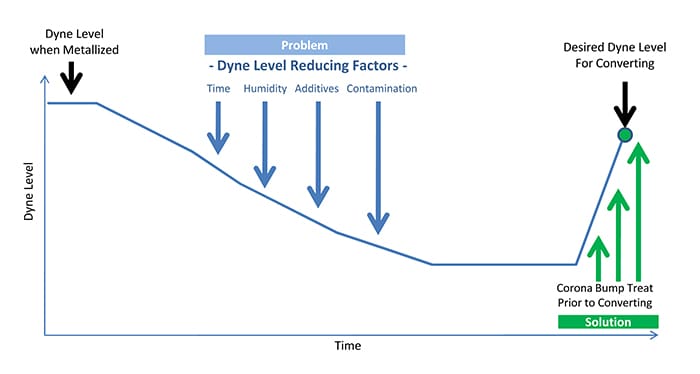Coating Adhesion for Films with Corona, Flame & Plasma
Successfully applying a high quality, continuous web coating requires advanced and versatile technologies which can effectively meet the varied needs for films. Surface treatment plays an important role in this process. The properties of the substrate are therefore absolutely critical to ensure good coating quality and product performance. The substrate needs to be uniformly wetted…
Read MoreWhy All Films Do Not Treat the Same
The Signature Relationship Between Your Film and Corona Treaters How well do you understand the relationship between your films and your corona treater? A treatment level of 2.0 watt density yields very different results on PET compared to Polypropylene. And, a nominal change in watt density can produce unexpected results. This paper looks at the…
Read MoreWhich Surface Treating Technology is Best for my Application?
Corona, Plasma or Flame? Surface treating in the converting industry is used to improve the adhesion of engineered films and foils that would otherwise be unreceptive to bonding with inks, coatings, and adhesives. As the only industry supplier who manufactures corona, plasma and flame treatment technologies, Enercon Industries Corporation offers unique insights on how these…
Read MoreProper Dyne Testing Methods: Buddy, Can You Spare a Dyne?
Dyne Tests Only Work When You Do Them Right Dynes are used to measure changes in a film’s surface energy. But poorly executed dyne tests produce unreliable results. And false assumptions about dyne levels, adhesion and corona treating leads to major problems. This insightful technical paper reviews best practices for dyne pen, cotton swab, and…
Read MoreTAPPI Mayer Rod Drawdown Dyne Testing
The Mayer Rod Drawdown Method is an industry standard under TAPPI Test Method T 552: Determination of Wetting Tension of Polyolefin Films and Coated Surfaces via the Mayer Rod Technique. How to apply:A substrate sample, usually measuring 8-1/2 x 11 inches, is clamped to a clipboard. At the top of the sample, a single drop…
Read MoreASTM Cotton Swab Dyne Testing
The Cotton Swab Method is recognized as an industry standard under ASTM D2578-17, Standard Test Method for Wetting Tension of Polyethylene and Polypropylene Films. Dyne solutions of various concentrations are placed on the substrate until a solution is found that wets out properly. How to apply:Drops of a dyne test solution are placed on the tip…
Read MoreWhy do I need corona treating and how do corona treaters work?
Corona treating increases the surface energy of plastic films, foils and paper to improve wettability and adhesion of inks, coatings and adhesives. Treating works best when a substrate is treated at the time of extrusion and in-line prior to converting. Corona treating increases quality and productivity through improved print quality, faster press speeds and less…
Read MoreSolving Metallized Film Converting Adhesion Issues
Most application questions involving the converting of metallized films concern the dyne level required to convert. It is extremely important for both the film manufacturer and the converter to recognize that achieving a specific dyne level does not guarantee printing, coating or laminating adhesion. Most converters will conduct a dyne test on metallized film prior…
Read MorePrevent Backside Treatment
The bad news is that backside treatment mitigates the effects of surface treating. In some cases, it results in under treatment of substrates. It can also raise the energy of the backside surface creating processing problems. In bag making and seal applications, backside treatment can alter the substrate’s co-efficient of friction. This will ultimately cause…
Read MoreHigh Performance PVD and PVDF Films Benefit from High Definition Corona Treatment
PVD (polyvinylidene) and PVDF (polyvinylidene difluoride), also known as brand names Tedlar® and Kyner®, are films with remarkable capabilities for a variety of applications. From release liners to spaceship bio barriers, these films offer purity and strength while resisting solvents, acids, and heat. These films are used in battery, aerospace, architectural, solar, printed circuit boards,…
Read More










